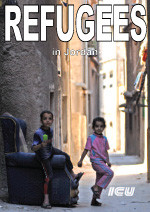 When in Europe we talk about Palestinians, or rather of Palestinian refugees, it is inevitable to refer to the “Palestinian question”: the conflict for antonomosia, the prototype of peace possible (or impossible), the soil more scope to measure internationally recognized diplomatic skills.
When in Europe we talk about Palestinians, or rather of Palestinian refugees, it is inevitable to refer to the “Palestinian question”: the conflict for antonomosia, the prototype of peace possible (or impossible), the soil more scope to measure internationally recognized diplomatic skills.
The most sought after opportunity to affirm the primacy of certain values (justice, defense, life) of others.
The “Palestinian issue” unleashes global wars and local guerrillas, violent protests and peaceful rivers of proposals: all justified in the name of the search for a definitive solution.
Anyway, it is natural to be so: 60 years have passed from what the Jews call “Yom Ha’Azmaut” -the Independence Day and the Palestinians define “Nakbeh” -the catastrophe, and a solution to the problem It has been found yet. Since 1948, when Israel declared its independence, at least 4.5 million Palestinians are refugees abroad. Since then refugee -and not only ones- there is a supreme right: “the right of return” and a priority: to keep alive the memory, the memory of life before ’48.
“I come from there and I remember” rightly says Mahmoud Darwish, the Palestinian poet. And that is what is handed down from father to son for 60 years. For a people forced to refugee status permanent, memory, roots, history is the only way to react -pacificamente- humiliation, the sense of injustice. And that’s why when it comes to Palestinian refugees, speaking relentlessly of the Palestinian issue.
Who are the Palestinian refugees today?
We know from where they come, it is a prerequisite to begin each conversation. “I come from there”, they say. Gaza, Tulkarem, Haifa, Jerusalem and so on. How they lived, we know as well. And if not a personal memory the ones of parents, grandparents, uncles will be vivid. But how do they live today? How they are located in places where they have found refuge? How different are the new generations? What prevails: memory, memories of wrongs, the retreat to the past and the consequent risk of inaction, or the desire to build a better life with confidence, despite the wrongs.
Driven by this curiosity, we went to meet them. In Jordan, the country that has hosted the largest number of Palestinians: one million and seven hundred thousand as a result of the conflict of the war of ’48 and ’65 that have been offered shelter and assistance. We went in the 13 refugee camps in which they live that part of the population in most difficulty, where ICU has worked for 10 years-thanks to the support of the European Union – with the aim of improving living conditions through infrastructure rehabilitation, training courses, micro credit.
The meetings led to this photo report, which certainly does not claim to provide a comprehensive picture of the condition of refugees in the country. It responds, rather, to the desire to offer the interested reader a glimpse of daily life, fragments of life, and the ambition to return to the people encountered, beyond of their being “refugees” with a past to remember and a future to be resolved, the right to be men and women who, as they can, share the present time.



